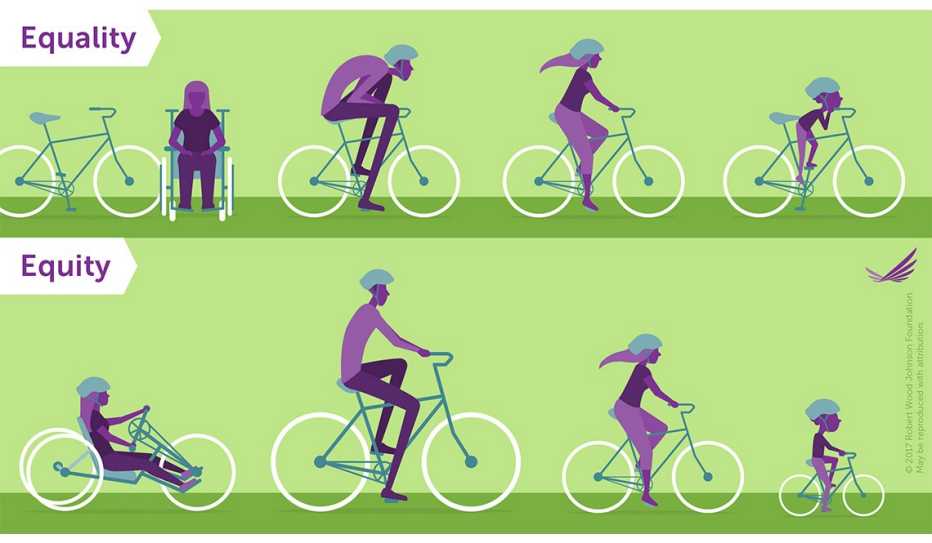AARP Hearing Center


The towns, cities, counties and states enrolled in the AARP Network of Age-Friendly States and Communities strive to create great places for people of all ages. Several of the network’s member communities have placed equity at the forefront of their work, including by reckoning with past decisions, norms and long-standing policies that shape the built environment and have manifested in unequal and uneven conditions. Links to articles about the efforts of 11 communities appear further down on this page.
Although the 8 Domains of Livability — upon which the AARP age-friendly framework rests — do not explicitly address equity, they do provide a fulsome context for addressing disparities and establishing goals and activities that deliver better and more equitable outcomes.
Community Responses:
ARIZONA
CALIFORNIA
FLORIDA
GEORGIA
HAWAII
OHIO
PENNSYLVANIA
TEXAS
Local leaders are demonstrating how equity approaches can be advanced and accelerated through their age-friendly work.
In some cases, the term “equity” is clearly used in the age-friendly action plan and is established as a core value that shapes the community’s work. In others, equity is not explicitly mentioned, but the age-friendly approach — one that strengthens participation for and representation of underrepresented groups — has nevertheless been successful at delivering more equitable outcomes in housing, transportation and public spaces.
This page contains links to stories that showcase the ways towns, cities and counties are using the livability domains to address disparities that impact, among other groups, people of color, members of the LGBTQ community or low-income households. The stories reflect a journey to better ensure that the voices, concerns, needs and wishes of vulnerable or overlooked populations are heard and acted upon.
Community practices include disaggregating data to understand the needs of low-income seniors and targeting resources to them; ensuring that programming is accessible, culturally-relevant and translated if needed; and partnering with others to build relationships, trust and greater impact.
The ability of local leaders to deliver upon goals and activities that enable opportunities and broaden access reveals the ability of age-friendly work to create communities that serve the needs of all residents.
Solution Themes
Supporting Seniors: By engaging older residents from a variety of neighborhoods and demographic groups, local leaders empower residents to impact outcomes. (Examples of this work can be found in the articles about West Hollywood, California, and Wilton Manors, Florida, among others.)
Culturally Distinctive Programming: Information is being provided in multiple languages, culturally appropriate foods are being served, and meeting are happening in places where people already gather and feel comfortable. (Examples of this work can be found in the articles about Austin, Texas, and Miami-Dade County, Florida, among others.)
Partnerships: Work is being done by and with organizations that have existing ties to particular communities. (Examples of this work can be found in the articles about Pittsburgh, Pennsylvania, and Honolulu, Hawaii, among others.)
Transportation: Efforts are underway to advance safer, more "complete" streets in at-risk communities and low-income neighborhoods. (Examples of this work can be found in the articles about Tucson, Arizona, and Atlanta, Georgia, among others.)
Prioritizing Places: Outreach and other efforts are being directed toward communities with significant or specific needs based on research and data. (Examples of this work can be found in the articles about Columbus, Ohio, and San Antonio, Texas, among others.)
Making Policy Changes: Improvements to government approaches can expand transportation choices, municipal services and housing options. (Examples of this work can be found in the articles about Austin, Texas, and Philadelphia, Pennsylvania, among others.)
Disrupting Disparities
AARP New York has led a multiyear effort known as “Disrupt Disparities,” which seeks to identify and address the ways older adults do not equally benefit from access to secure housing, health and communities. Noting that access varies widely across racial and income groups, the work has resulted in policy recommendations that, when adopted, can result in more equitable and livable communities. (Find AARP New York’s findings and policy recommendations here.)
This state-led focus has expanded into an AARP-wide effort in which equity is defined as an approach and process “to achieve fairness and impartiality by offering different interventions targeted to individual needs and conditions in order to make opportunities the same as another's.”
One component of AARP's ongoing work related to equity, diversity and inclusion is the AARP Equity by Design dialogue series. Hosted by AARP International, built-environment leaders from throughout the world share their perspectives about why equitable, diverse, multigenerational communities are so needed and what it will take to achieve them.
Related
- AARP Network of Age-Friendly States and Communities home page
- Age-Friendly Network Communities Articles Archive
- Equity and Livability Archive
Reporting for the community profiles occured in late 2020.



























































